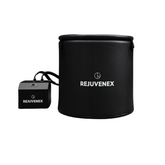Dry Sauna vs Wet Sauna: Which One Is Right for You?
When choosing between a dry sauna and a wet sauna, many people feel unsure. Both offer relaxation and health benefits, but they differ in heat, humidity, and effects on your body. This guide compares dry saunas and wet saunas to help you decide. We’ll cover how they work, their benefits, drawbacks, and practical tips for use. By the end, you’ll know which sauna fits your needs.
Experience the Ultimate Relaxation with Rejuevex Saunas! 🌿✨
Looking for the perfect way to unwind while boosting your health? Rejuevex Saunas offer advanced infrared technology to help you detox, relieve stress, and rejuvenate your body from the inside out.
What Is a Dry Sauna?
A dry sauna uses dry heat to warm the air. Typically made of wood, it relies on an electric heater or wood-burning stove with hot rocks. The temperature ranges from 160°F to 200°F, with low humidity (10-20%). This creates a hot, arid feel, like a desert.
Dry saunas originated in Finland centuries ago. They’re designed to make you sweat without steam. Some models let you pour water on rocks for a brief humidity boost, but the air stays mostly dry.
Benefits of a Dry Sauna
-
Heart Health: Studies show regular dry sauna use may lower risks of heart disease and improve blood pressure.
-
Muscle Recovery: The heat relaxes tight muscles, helping athletes recover faster.
-
Detoxification: Sweating flushes out toxins like heavy metals (e.g., lead, nickel).
-
Skin Health: Opens pores and boosts circulation for a clearer complexion.
Drawbacks of a Dry Sauna
-
High heat can feel intense or uncomfortable.
-
Not ideal for people with respiratory issues like asthma.
-
Risk of dehydration if you don’t drink water.
What Is a Wet Sauna?
A wet sauna, also called a steam room, uses moist heat. Steam comes from a generator or water poured over hot rocks. Temperatures are lower (90°F to 120°F), but humidity hits 100%. The air feels thick and misty, like a tropical jungle.
Wet saunas are common in spas and gyms. Materials like tile or glass line the walls to handle moisture. The humid environment hydrates your skin and airways.
Benefits of a Wet Sauna
-
Respiratory Relief: Steam loosens mucus, easing congestion or asthma symptoms.
-
Skin Hydration: Moist heat softens dry skin and may help conditions like psoriasis.
-
Stress Relief: The warm, humid air promotes relaxation.
-
Lower Heat: Easier to tolerate for beginners or those sensitive to high temperatures.
Drawbacks of a Wet Sauna
-
High humidity can make breathing harder for some.
-
Moist conditions may breed bacteria or mold if not cleaned well.
-
Less intense sweat means fewer detoxification benefits.
Key Differences Between Dry Sauna and Wet Sauna
Understanding the differences helps you pick the right sauna. Here’s a clear comparison:
|
Feature |
Dry Sauna |
Wet Sauna |
|
Temperature |
160°F - 200°F |
90°F - 120°F |
|
Humidity |
10-20% (low) |
100% (high) |
|
Heat Source |
Electric or wood stove |
Steam generator or rocks |
|
Feel |
Hot and dry |
Warm and humid |
|
Best For |
Detox, muscle recovery |
Respiratory, skin |
Dry saunas deliver intense heat for sweating and detox. Wet saunas offer gentler heat with moisture for breathing and skin benefits.
Which Sauna Is Better for Your Health?
Both saunas boost wellness, but their benefits depend on your goals.
For Cardiovascular Health
Dry saunas shine here. Research links them to lower risks of heart attacks and better blood flow. The higher heat raises your heart rate, mimicking light exercise.
Wet saunas also help circulation but lack the same research depth. The gentler heat still relaxes blood vessels.
For Muscle Recovery
Dry saunas win for athletes. The deep heat loosens stiff muscles and speeds recovery after workouts. Wet saunas help too, but the effect is less intense.
For Respiratory Issues
Wet saunas are better. Steam opens airways, making it easier to breathe if you’re congested or have allergies. Dry saunas might dry out your lungs instead.
For Skin Care
Wet saunas hydrate skin, easing dryness or flakiness. Dry saunas detox through sweat, improving clarity but not moisture.
How to Use a Dry Sauna or Wet Sauna Safely
Saunas feel great but require care. Follow these tips:
Dry Sauna Tips
-
Stay for 10-20 minutes per session.
-
Drink water before and after to avoid dehydration.
-
Shower first to remove oils that block sweat.
Wet Sauna Tips
-
Limit sessions to 15-20 minutes.
-
Breathe slowly if the humidity feels heavy.
-
Check for cleanliness to avoid germs.
General Safety:
-
Avoid saunas if pregnant, sick, or on medication (ask your doctor).
-
Stop if you feel dizzy or unwell
Dry Sauna vs Wet Sauna: Which Should You Choose?
Your choice depends on preference and needs.
Pick a Dry Sauna If:
-
You want intense heat and deep sweat.
-
You’re focused on muscle recovery or detox.
-
You enjoy a dry, desert-like feel.
Pick a Wet Sauna If:
-
You need respiratory relief or skin hydration.
-
You prefer gentler heat with moisture.
-
You like a misty, spa-like vibe.
Still unsure? Hybrid saunas combine both! They let you switch between dry heat and steam.
Answers to Common Questions (People Also Ask)
Is a Dry Sauna or Wet Sauna Better for Weight Loss?
Neither burns fat directly. Weight loss in saunas is just water from sweat. You’ll regain it after drinking. For real weight loss, pair sauna use with exercise and diet.
Can I Use a Sauna Every Day?
Yes, if you’re healthy and stay hydrated. Start with 2-3 sessions weekly, then increase if comfortable.
Which Sauna Feels Hotter?
Wet saunas often feel hotter due to humidity, even at lower temperatures. Dry saunas are hotter but feel less sticky.
Are Saunas Good for Colds?
Wet saunas may ease congestion, but avoid saunas if you have a fever. The heat could worsen it.
Infrared Saunas vs Dry/Wet
Infrared saunas use light to heat your body directly, not the air. They run cooler (120°F-150°F) and may penetrate deeper for pain relief. Compare them to dry (hotter) or wet (humid) options based on your comfort.
Unique Benefit for Stress
Both saunas lower cortisol, the stress hormone. Wet saunas add a soothing mist, while dry saunas offer a bold heat escape.
Final Thoughts: Make Your Sauna Choice
Dry saunas bring intense heat, detox, and muscle relief. Wet saunas offer moisture, respiratory help, and skin hydration. Think about your health goals, comfort, and budget. A home sauna—dry, wet, or hybrid—can elevate your wellness routine.




